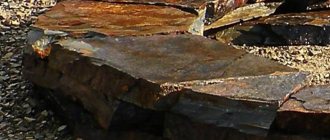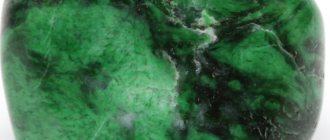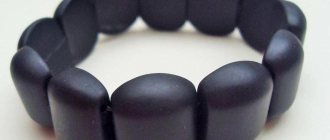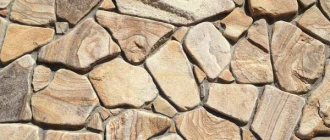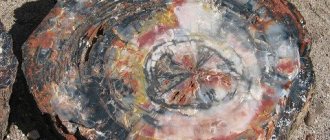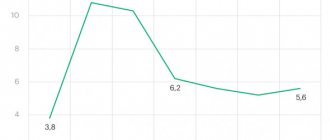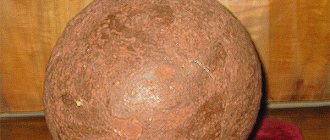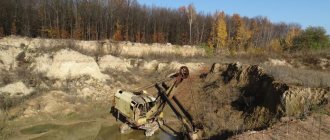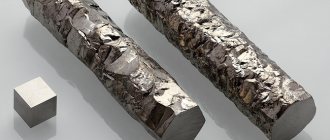What is bauxite
The stone was discovered in France in 1821. A useful discovery was made by Pierre Berthier, a French mineralogist and geologist. The name was given in honor of the village next door - Les Baux.
A small piece of bauxite was presented at the Paris Exhibition in 1855. The sign said "clay silver." Since then, the stone has been actively studied. The researchers clarified the chemical formula, described the physical properties and other characteristics.
Compound
Bauxite is an ore that consists of oxides of aluminum, silicon, iron and other substances. Some classify the rock as a mineral. The formula for bauxite shows that there is a lot of aluminum hydroxide. Industrialists are usually interested in alumina. Sometimes its content in this breed is up to 40–60% or more.
The formula of bauxite in chemistry is Al2O3*xH2O. The composition is very different. Here they find up to 100 elements from the periodic table.
The main “component” of the mineral is aluminum hydroxide.
The more it is, the more valuable the stone is for industry. The amount of silica and other numerous impurities are taken into account: silicates, carbonates, potassium and others. It is important how easy it is to separate alumina and aluminum oxide from the rock. This characteristic is called openability.
Other properties of bauxite:
- Specific gravity varies greatly depending on the location of extraction. For example, if the composition contains a lot of silica, this value is about 1.2 g/cm³. The specific gravity of dense samples, which contain more iron, is already approximately 2.8 g/cm³.
- The hardness of bauxite also varies greatly: from 2 to 7 on the Mohs scale.
- The rock often resembles clay. However, this impression is deceptive. The mineral, upon contact with water, does not turn into a flexible mass such as plasticine. There is also a lot of aluminum in clay, but there it is in a different form.
- Cleavage is absent.
- There is no syngony, that is, the mineral is amorphous.
- Structure may vary. There are stones with large pores and dense, hard specimens.
- Dim, low shine.
- Opacity.
- Density varies - from 2.5 to 3.5 g/cm.
Bauxite contains diaspores. These are hard stones: 6.5–7 on the Mohs scale. Such rocks are used to produce aluminum. There is a lot of Al2O3 in the diaspora - about 85%.
Value
Explored mineral deposits are not always developed. Sometimes the ore does not have suitable characteristics or development is not economically feasible. Before mining, the quality and value of the rock is assessed. The samples determine, for example, the following:
- A form of aluminum hydroxide.
- The composition of various impurities and the proportion of each of them. Valuable bauxite is one that contains a lot of alumina and silica.
- Openability - ease of obtaining aluminum oxide. This simplifies the work, makes it cheaper and more profitable.
It is not possible to determine the quality of a mineral by appearance. It's changing too quickly. The value will be determined after examination in the laboratory.
Appearance
Bauxite looks different. Sometimes they resemble clay, hard stone, or something in between. There are other appearance features:
- There are porous and denser specimens.
- There are stones with inclusions. The latter are small round bodies made of alumina and iron.
- The color varies, which is explained by the rich composition. Bauxites are found with colors ranging from white to dark red. Most minerals are brown or brick-colored.
Production
Almost all known deposits of this stone are concentrated in 18 countries. There are two types of deposits. Depending on the origin there are:
- Residual chemogenic. Here the rock, which contains a lot of aluminum, has been “processed” by nature for a long time. It was subjected to chemical action (lateralization) and weathering in a hot climate. The result was ore. Most of the deposits in the world are just like this. Due to their composition, bauxite from sedimentary deposits produces aluminum oxide more easily and is considered to be of higher quality.
- Sedimentary-chemogenic. Here bauxite appears from the products of mechanical and chemical weathering. They are found in pits of different nature. Stones in such deposits often occur in layers. The mineral in each of them differs in quality. In some layers, bauxite is replaced by clay. The openability of such stones is worse, and enrichment is more difficult.
Bauxite is usually mined by open-pit mining. Underground mining is rarely used. The strata sometimes lie at the bottom of the sea.
Compound
In order for the formula of bauxite in chemistry to accurately reflect the composition of the mineral, it is necessary to take into account all the substances that are included in it. There are many of them, let’s name the ones that occur most often:
- aluminum oxide hydrates, you are already familiar with it - Al2O3xnH2O;
- iron hydroxides, oxides and silicates forming the ore mass;
- silicon (quartz (SiO2), opal (SiO2 x nH2O), kaolinite (Al4[Si4O10](OH)8));
- titanium (rutile (TiO2) and others);
- carbonates (CaCO3, MgCO3, etc.);
- compounds of chromium, zirconium, phosphorus, sodium, potassium, vanadium, gallium and other elements;
- pyrite (FeS2).
Ore is valued primarily if it contains alumina, and the less silica, the better. To characterize the quality, the so-called silicon module of bauxite was introduced, the formula for finding it is: μSi = Al2O3/SiO2. The resulting value shows which method is best for processing ore.
Main varieties
All bauxites have the same designation, although they are very different. Types are distinguished according to several characteristics:
- According to physical condition and density. There are earthy and clay-like, loose and hard. Some varieties have pores in their structure.
- There are stones of round shape and in the form of fragments.
- Some minerals have a more or less uniform structure, while others have noticeable layers.
- According to the nature of formation, they are divided into residual and sedimentary stones. This affects quality and suitability for production.
- By composition. It can be very different. They are divided into hydrargillite stones, boehmite stones, diasporic stones, and mixed stones. Varieties include, for example, nepheline-containing ore and alunites.
- Color: white, black, brown, green, gray.
TOP 10 countries for bauxite mining in the world and why its extraction is so expensive
Moscow, 04/27/2021, 03:54:03, editorial office PRONEDRA.RU, author Inna Mordasova.
Aluminum is an extremely light metal, but due to its characteristics, the raw material is used in many industries. It is used in aviation, shipbuilding, as well as the production of cars and ships. The use of aluminum became truly widespread during the Second World War.
To obtain the metal, bauxite is used, a resource whose extraction sources are found in 18 countries. As a rule, they are all characterized by a hot climate with sufficient moisture. In addition to bauxite itself, substitutes can also be used, but their use is less cost-effective. These include anorthosite, alunite, oil shale and other resources.
Features of processing
The quality of the stones, on which the processing method depends, is determined in the laboratory. The “silicon module” is calculated using the formula MSi = Al2O3/SiO2. Then do the following with the mined ore:
- Higher quality bauxites (with high results) are processed using the Bayer method. As a result, alumina becomes sodium aluminate. Next, the resulting solution is cleaned of red mud. The alumina precipitates and is leached. The output is aluminum.
- For the rest, the sintering method is used. The treatment is carried out at high temperature: +1250 °C. Special rotary kilns are used. Crushed bauxite, soda and limestone are thrown there. All this is sintered and then leached. Aluminum hydroxide is precipitated and filtered.
Rock processing
Bauxite is mainly mined using the open-pit method, but sometimes also underground. The method of deposit development depends on the nature of occurrence of mineral rocks and the concentration of metal in the ore. Various processing technologies are used, which are influenced by the composition of the rock.
Aluminum production consists of the following stages:
- obtaining from alumina using chemical methods;
- separation of purified metal using electrolysis of aluminum fluoride salts.
Alumina is produced by the Bayer hydrochemical method (sintering) and combination: parallel and sequential methods. The main feature of Bayer's technology is based on the leaching of bauxite to produce concentrated sodium. After this, the alumina goes into a solution of sodium aluminate, which is purified to remove the red mud, and the alumina is precipitated. Next, leaching is carried out to produce aluminum.
The processing of low-quality bauxite is carried out using complex technology, which involves sintering a crushed mixture with limestone and soda at 120 degrees in special furnaces, which rotate during operation. After this, the resulting cake is leached with a low concentration solution, and the precipitated hydroxide is filtered.
The above methods for producing aluminum are complex, but with their help, maximum volumes of metal are obtained from ore.
World bauxite reserves
In 1974, there were approximately 19 billion tons of this ore on Earth. True, the scientists’ assessment had errors, since it did not include the huge Soviet Union. At that time, there were only 5.2 billion tons of reliable proven reserves.
In the first decades of the last century, almost all bauxite was mined in developed countries. And today work is underway there, for example, in Italy and France. Although there is little stone in Europe - a maximum of 7% of world reserves. These minerals are also scarce in the United States.
In the 60s, states from the Caribbean Sea became leaders: Guyana, Jamaica, Suriname. Today, the main countries in production are Guinea, Australia, Brazil and some other countries. There are bauxites in Russia too. Deposits have been discovered, for example, in the Urals and the Komi Republic.
Origin and deposits of bauxite
The rock is formed as a result of weathering of acidic and alkaline formations of igneous origin in hot climates (lateritic bauxites) or through sedimentary processes in coastal marine regions and on continents in the form of layers and lenses.
Bauxites of coastal origin are located mainly on limestones. Continental deposits form on slopes, in valleys, lake basins and karst sinkholes.
Bauxite deposits are located throughout the world, but the largest volumes of the stone are mined in Guinea, Australia, Vietnam, Brazil, Indonesia, India, Jamaica, Mali and Cameroon. It is in these countries that up to 65% of all world deposits are located.
Russia is not so rich in bauxite reserves, so raw materials have to be imported to cover industrial needs. The most significant deposits are located on the Yenisei Ridge, in the Leningrad and Astrakhan regions, the Komi Republic, the Sayan Mountains and the Urals. Mining in small quantities is carried out in the northern regions of Kazakhstan and Central Asia.
Areas of application of the mineral
This is a valuable raw material for industry. Alumina is obtained from bauxite. It is used in different ways, for example, they do the following:
- Molding material.
- Flux for ferrous metallurgy.
- High-quality refractories that are not afraid of temperatures or loads.
- Special dense cement with excellent physical properties. The solution hardens quickly and bonds perfectly to the reinforcement. The resulting concrete is resistant to high temperatures and acidic environments.
- Alumina is ground and used in the production of anti-oil spill products.
- Pure aluminum for various products.
Bauxite has also been used in other areas. From them we get:
- electrocorundum is an excellent jet abrasive for industry;
- metal compounds for the production of pigments.
Bauxite is a valuable find for humanity. The ore is used in the chemical industry, construction, and metallurgy. The world's reserves will last for a long time. Due to its use in the military-industrial sector, the breed is considered strategically important.
Production
The appearance of minerals requires enhanced weathering of bedrock aluminium-containing rocks. Due to the fact that the process of stone destruction actively occurs in hot areas, most of the bauxite deposits are located in the tropical region.
Over 90% of ore reserves are located in 18 countries. There are few bauxite deposits in the Russian Federation; raw materials are mainly imported. The highest quality minerals are mined in the Northern Ural region. There are also deposits in the Boksitogorsk region, Arkhangelsk, Belgorod, Sverdlovsk and Leningrad regions. The most promising source of raw materials is the Sredne-Timan deposits located in the Komi Republic. Explored reserves total more than 250 million tons.
The largest deposits are located in the following countries:
- Guinea - approximately 20 billion tons;
- Austria - over 7 billion tons;
- Brazil - approximately 6 billion tons;
- Vietnam - 3 billion tons;
- Indonesia, India - 2.5 billion tons.
In Azerbaijan, at the Zaglik deposit, a rare type of bauxite is developed - alunite. Its reserves total over 200 thousand tons, but deposits of alunite ores have also been found in Uzbekistan. They were discovered in the Gushtai deposit in an approximate volume of 130 million tons. But currently no deposits are being developed, so Azerbaijan is the only country where alunites are mined.
TOP 10 countries for bauxite mining
The existence of metal deposits in the amount of about 30 billion tons has been proven. This amount of raw material for aluminum production should be enough for many centuries. Moreover, five countries have reserves of 70% of all bauxite.
Aluminum production requires a large amount of electricity. At the same time, bauxite is a transportable raw material, because it is mined in geographically remote countries. Consumers of the resource are developed countries with a huge energy base. It is not for nothing that most industrial enterprises operate near hydroelectric power stations. This makes it possible to reduce the territorial accessibility between mines for aluminum production and factories for its production. Among the leaders in aluminum production is Australia, whose annual share of production is 75 million tons. It is followed by China with 70 million, as well as Guinea with 50 million tons.
| N | A country | Production in 2004 (million tons) | Reserves at the end of 2004 (billion tons) | Share in world production (%) |
| 1 | Australia | 56 | 4,4 | 35,90 |
| 2 | Brazil | 18,5 | 1,9 | 11,86 |
| 3 | Guinea | 15,5 | 7,4 | 9,94 |
| 4 | China | 15 | 0,7 | 9,62 |
| 5 | Jamaica | 13,5 | 2 | 8,65 |
| 6 | India | 10 | 0,77 | 6,41 |
| 7 | Venezuela | 5,5 | 0,32 | 3,53 |
| 8 | Russia | 5 | 0,2 | 3,21 |
| 9 | Suriname | 4,2 | 0,58 | 2,69 |
| 10 | Greece | 2,4 | 0,6 | 1,54 |
| 11 | Guyana | 1,7 | 0,7 | 1,09 |
| Other countries | 9 | 3,72 | 5,77 | |
| Total worldwide | 156 | 23 | 100,00 | |
